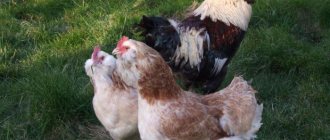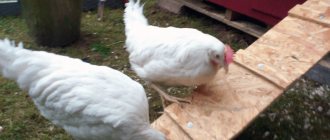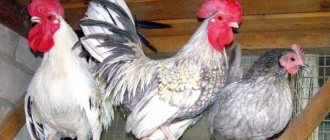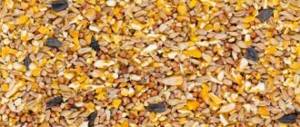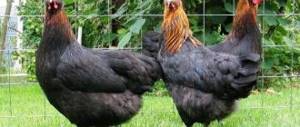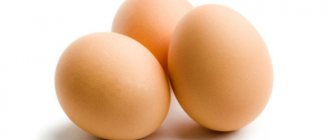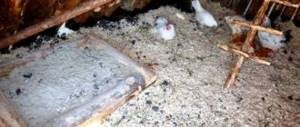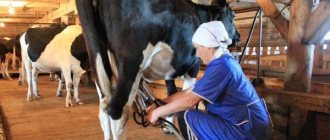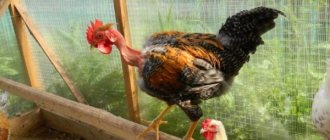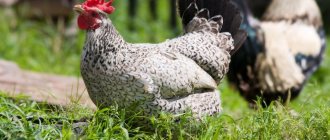The Poltava clay breed of chickens, bred in Ukraine, has a meat and egg production orientation. Therefore, it is considered beneficial for keeping on small farms and large farms. The peculiarity of Poltava clay chickens is their resistance to the external environment and immunity to harsh climates. In addition, they do not require complex care and easily tolerate errors in maintenance. However, certain requirements must still be met.
Where did the breed come from?
The Poltava breed of chickens was bred in the region of the same name in Ukraine in the 19th century. The Wyandotte, New Hampshire and Orpington breeds were used for crossing.
The goal was to breed universal birds that would produce a lot of eggs, provide dietary meat, and be frost-resistant.
Selection work went on for two centuries, but was suspended with the collapse of the USSR. Part of the breeding stock of Poltava chickens was reduced, and work to improve the breed was postponed.
Due to negative changes, the breed has lost some valuable qualities. But today work continues to improve the characteristics - breeders are trying to achieve the same results.
Officially, Poltava chickens received recognition only in 2007.
A description of the Poltava clayey rock will allow you to get an idea of its main characteristics.
What breed of chicken is best to avoid?
In principle, almost all breeds of laying hens offered on the domestic market are capable of laying eggs in farms and households in any region. The only question is how many eggs they will lay and what kind of care the bird will need. Since it’s a matter of choice, it’s better to refuse to grow “Minocorks”.
Chickens are characterized by a high rate of egg production. Adults have a slender, elongated body, a long neck, a small head with a large red crest. The feather color can be black, white or brown. The eggs are laid in a white, strong shell.
So, why then is it undesirable to start a breed at home if egg production is high? The thing is that the bird was bred in Spain, and it loves warmth very much. In the southern regions, chickens will still be comfortable. If we take, for example, the Moscow region, not to mention the Siberian region, with the sudden onset of cold weather, egg production will drop sharply. In severe frosts, the ridges can actually freeze. Even if it is possible to provide a chicken with warm living conditions, it needs a lot of walking, otherwise you can forget about productivity.
The video shows the best breeds of laying hens:
To summarize the review of breeds, it should be noted that laying hens for breeding should be purchased from trusted producers. This is the only way to guarantee that you will get a pure breed and not a mixture.
Chickens
Varieties
There are three lines of Poltava rock: clayey, black, zozulyasty.
The black subspecies is mainly bred in Poltava. There are only a few dozen representatives of this breed line, but breeders do not lose hope of increasing their number.
Zozulyasty Poltava chickens are also called cuckoo chickens. Chickens have beautiful plumage: a wide stripe of light color alternates with dark. They are lightweight. The species is on the verge of extinction.
Clay Poltava chickens are the main representatives of the breed; there is a large population. This species is common in Russia and the CIS countries.
Next, the characteristics of the clayey variety of rock are discussed in detail.
Peculiarities
Build and color
On the small head of clay Poltava chickens there is a pink comb. Its common form is in the form of a rose; leaf-shaped is less common. The eyes are yellow-red, the earlobes and earrings are red, covered with small white dots. The small beak is yellow. The face has pink or red bristles.
The birds have a short and strong neck, a rounded chest, and a wide and long back. The wings fit tightly to the body. An obtuse angle is formed between the body and tail. The legs are yellow with slightly protruding shins, widely spaced and not covered with feathers.
Chickens of the Poltava clay breed have brown plumage: from light to dark shades. The tip of the pen is painted black.
You can distinguish a cockerel from a hen by several characteristic features:
- long and light neck;
- black tail feathers with green tips;
- along a more developed torso;
- body weight (more than that of females by 1 kg);
- large comb with 5 teeth.
Bird character
The Poltava clay hen is distinguished by its developed maternal instinct. She diligently sits on the clutch and then takes care of raising chickens. Not aggressive towards other animals and birds.
Chickens are friendly towards people. They allow them to clean the house and withstand any manipulation. Roosters are characterized by smooth and decisive movements. The birds do not fight among themselves; they are loyal to representatives of other breeds.
Poltava clay breed of chickens: breed overview
This breed belongs to the meat-egg group (a universal type of poultry). This means that it is profitable to keep them both on a large farm and on a private farmstead, because you can get lean meat that is good in taste and a large number of eggs. How do these chickens differ from other varieties of poultry?
History of the breed
Raising chickens on your farm is quite economically profitable.
And each of the breeders will be happy to purchase a breed that will be quite hardy, with strong immunity, quickly gets used to new conditions of keeping, and does not require special conditions of keeping.
And if this bird is also distinguished by its high frost resistance and good productivity, then the only places where it cannot be bred are Antarctica and the Far North.
And, of course, keeping frost-resistant laying hens, characterized by good egg production and rapid weight gain, in the conditions of Siberia, Trans-Urals and other regions with a similar climate is cheaper than bringing such products from afar.
Breeding frost-resistant species of this bird has been one of the main problems of domestic breeders for a long time.
After all, approximately half of Russia's territory is characterized by a fairly cold climate - with harsh winters and a cool summer season.
And both farmers and private entrepreneurs in any region want to have laying hens in their backyard that will lay eggs regularly. And if you can still get tender dietary meat from them, then that’s just wonderful.
Chickens of the Poltava clay breed get along well in the poultry house
Therefore, breeders in our country have been closely involved in breeding cold-resistant chickens over the past two centuries. And we achieved certain positive results - several frost-resistant breeds were bred:
Poltava clay chickens are one of the “youngest” species of the above.
The basis was taken from local Poltava chickens, which were crossed with the most famous foreign ones - Orpington, New Hampshire and some others.
The native birds of Poltava were taken as a basis, as they were one of the best local breeds.
Their merits were repeatedly noted at agricultural exhibitions in the late 19th and early 20th centuries, and before the Patriotic War, these birds showed good egg production (up to 100 eggs per hen per season).
At that time this was very good productivity. And in the middle of the last century, the Poltava Clay was officially included in the State Register as a new breed of chickens.
Characteristics of Poltava chickens
Poltava laying hens are chickens with a calm character, completely unpretentious and quickly adapt to any living conditions. They have a very strong immune system, excellent health, the chicks are born strong, and there is practically no waste when raising chickens. However, these chickens may suffer from parasitic infections (such as coccidosis).
Poltava clay rock
This breed is distinguished by amazing sociability and flexibility. They can get along with any type of poultry. Roosters are not loud-mouthed and are not pugnacious, so there is no need to move them to another room.
There are several varieties of Poltava chickens. They differ in plumage color, body weight and some other external features.
- The most popular among farmers is clay layer. Their feathers are yellow with a brown tint (occasionally fawn). The pink comb of this bird looks like a crown. The head size is medium, the neck is short, turning into a fairly wide back, the chest is rounded. The limbs are lemon-colored, practically devoid of vegetation. The beak is strong, small, yellow in color. Some chickens have a “collar” of black feathers on their necks.
- The next variety is black. They are very similar to clay ones, only the color is different - blue-black.
- Zozulya species - these chickens are similar in color to cuckoos (“zozulya” translated from Ukrainian as “cuckoo”). They differ from other varieties in their lighter weight - up to 2.5 kg.
Zozulistaya breed of chickens
The last two species are rarer; they are most often bred by breeding farms to preserve the breed.
Exterior of the Poltava rooster
Roosters of different types differ mainly only in the color of their feathers. The following features are common to all males:
- the neck is longer and lighter than that of the black-cloud;
- the ends of the tail feathers are raven-colored;
- the body and back are better developed than those of chickens;
- the average weight of a living adult male is 3–3.5 kg (and the weight of laying hens is about 2.5 kg).
Meat characteristics
Poltava clay hens weigh 2.5 kg, roosters weigh a little more - 3.5 kg. After processing the carcass, about 1.3 - 1.8 kg of live meat is obtained. Bones do not take up more than 11% of the weight.
The carcass of Poltava clay chickens is famous for the presence of a fatty layer - when cooked, it releases juice, making the pieces juicy and tender. Despite this, fillet is low in calories and can be consumed by people on diets.
Chicken feathers and down are valuable materials. The Poltava breed is distinguished by good plumage; up to 100 g of material can be collected from each bird. It is used to stuff pillows and blankets.
Breed characteristics
These chickens come from Ukraine, or rather its forest-steppe part. They are distinguished by a calm and balanced character, endurance and pickiness. It was bred in the Poltava region by mixing Wyandotte, New Hampshire and Orpington breeds and local chickens. If desired, photos and videos of these breeds can be seen on the Internet.
The appearance of these chickens comes in three types:
- fawn;
- zozulyasty;
- black.
The first variety is the most common. The bird's head is not large in size; as a rule, it is decorated with a comb shaped like a rose. However, sometimes you can find specimens with a leaf-shaped crest. Their eyes are dark yellow, close to red. The earrings and earlobes are deep red with white splashes. They are also distinguished by a small but strong beak. The head is placed on a strong and strong neck, which flows smoothly into a long and massive back. The tail is raised up, forming an obtuse angle.
In the photo, the Poltava chicken can also be recognized by its widely spaced yellow legs, with prominent shins. The tips of the flight wings are always edged with black feathers. Males always have lighter neck feathers than females.
The ancestors of Poltava chickens graced local exhibitions back in the late nineteenth century. And in the twenties of the last century, this breed demonstrated egg production that was amazing for those times. One hen produced about a hundred eggs a year, which was rare in those years. But as production developed on a large scale, the number of birds and their ability to lay eggs began to decline. Therefore, to preserve the productive capacity of the breeds, local breeders began hard work to develop productive varieties.
There are very few representatives of the black variety of the Poltava breed left, so at the moment breeders are closely involved in its restoration. The situation is also the same with the zosulest chicken, which is considered almost extinct. At the moment, large poultry farms are busy breeding clay, that is, fawn breed, Poltava chicken. It is perfect for constantly supplying the population with chicken meat and eggs.
This breed supposedly comes from Romensky district, located in the Poltava region. For more than fifty years, scientists have constantly improved this breed. However, only ten years ago the Poltava clayey was officially classified as a meat-egg chicken.
The live weight of an adult female ranges from two to two and a half kilograms, but roosters can grow to three or even three and a half. In this case, the meat yield is more than half, and the weight of the bones is a tenth of the total mass. Small layers of fat between the muscle spindles give the meat juiciness and distinct taste.
One clay hen can produce up to two hundred eggs per year. The egg shell is light brown in color, and the weight reaches almost sixty grams. Back in the eighties, scientists discovered that the Poltava breed lays eggs with a high protein content.
In addition, one should not ignore the high survival rates of these chickens. In adults it reaches ninety percent, in young individuals it reaches ninety-seven.
For chicken hatchability rates, a fluctuation of around eighty percent is true. At one day old the chicks are cream colored.
Egg production
Poltava clay chickens are in demand due to their early ripening.
The hen lays her first eggs at 20 weeks. In a year it turns out to be 200, in rare cases - 300 pieces.
The eggs are large, weight - 55 g. The shell is brown - a consequence of the work of the golden color gene. Thick and strong, contains a lot of calcium. Eggs have a predominant protein content, which makes them valuable for athletes building muscle mass.
Poltava chicken eggs have a high fertility rate of 83%. The survival rate of offspring is 100%.
The maximum peak of egg production is from 7 months to 1.5 years. They do not lay eggs during the molting period. By the fifth year of a bird’s life, it is reduced to 60% and it is unprofitable to keep laying hens any longer. Therefore, the livestock requires updating.
Characteristics and cultivation features
The hatchability of chickens is 80-83%.
Due to the well-developed brooding instinct, the age at which the first egg is laid is 140-150 days. The weight of roosters is about 3.2 kg, chickens - 2.1 kg. Egg production reaches 160 – 217 (!) eggs per year, and at the moment, individual record holders show an egg production of 290 eggs per year.
The weight of one egg ranges from 55 to 58 g. The shell is brown, since birds of this breed are carriers of the golden gene, which determines the color of the feather. Research on the eggs of this breed of chicken, conducted in 1982, showed excellent protein quality and impressive shell thickness.
The yield of meat reaches 52%, bones - 10.7%; the meat has a pleasant taste and juiciness due to thin layers of fat between the muscle spindles.
Chickens of this breed have high vitality.
Back in 1970 V.P. Stolyarenko and his colleagues noticed that embryos of Poltava chickens were more resistant to the Rous sarcoma virus compared to embryos of other breeds, and resistance to neoplasm was more than four times higher compared to embryos of other breeds, and in adult chickens - more than two times higher. times.
The birds are unpretentious, easily adapt to breeding conditions, and have a calm character, but chickens are afraid of the cold. They eat both any forage and combined feed. They are adapted to both outdoor breeding and cultivation in equipped cages of various types, including incubators for artificial insemination.
There are a number of general recommendations for the proper keeping of chickens. When breeding outdoors in a chicken coop, it is best to place the individuals on a bedding made of straw, sawdust or dry peat, which must be changed to avoid the accumulation of pathogenic microbes in it.
Preference should be given to the latter, since peat absorbs moisture from chicken feet, which prevents the spread of colds and also helps laid eggs not to break.
When breeding in special containers, bedding is not needed, but it is better to make the floor in the cage cellular so that excrement falls into the trays and does not infect the birds. It is better to keep the drinking bowl in the light and at some distance so that the birds do not swim in it. For heating purposes, 3-4 lamps must be placed in the cage.
Birds need walks. However, with free-range breeding, it is necessary to remember that chickens must eat, in addition to seeds and grass, stones for grinding chyme.
During the winter season, birds need to be fed twice a day, with soft food served during the day (for example, bran soaked in water, greens, meat), and grain in the evening; In summer, it is enough to feed once, the birds will consume the rest themselves when walking.
As for the peculiarities of keeping Poltava clay chickens, they especially love feed made from corn and corn production waste. For raising young birds of one day of age, the most suitable is a 24-hour light regime with a gradual reduction to 9 hours at 9 weeks of age and until the bird reaches 18 weeks of age.
At the age of up to 7 weeks, food should have increased caloric content and high protein content (20%). This will ensure adequate functioning of the breeding system to fully identify the genetic potential during the reproductive period.
Birds 7 weeks of age and older are fed feed with a low protein index (14%). Thanks to this, chickens reach optimal weight and sexual maturity.
It is necessary to prevent the bird from gaining weight, as this leads to obesity. When growing in batteries, both in industry and privately, males are first placed in a cage, and after 2-3 days females are added to them. The sex ratio in the population should be 1:8 (there are 8 hens per rooster).
Now chickens of this breed are kept only on personal plots or in collections in order to preserve the gene pool. In Russia, unfortunately, it is almost impossible to find a poultry farm that breeds them. You can buy a bird only in Ukraine or from a private person.
Reproduction
To successfully replenish the population, Poltava clay breed can be bred at home. The optimal ratio in the herd is 8 hens to 1 rooster.
The birds are distinguished by excellent maternal instinct and diligently sit on the masonry. It is necessary to check the nests regularly, as there is a risk of eggs brooding, causing them to deteriorate.
One hen hatches up to 15 eggs. The female is fed well and ensured that she drinks on time. You should not let her leave the nest for more than 15-20 minutes a day.
Chicks of the clayey Poltava breed hatch in 21 days. It is better to start breeding in April and end in the fall, since in the warm season there is an abundance of succulent food.
The weight of the chicken is on average 40 g, the color of the down is light brown. With proper nutrition, the chick reaches a weight of 250 g in the fourth week.
The appearance of babies
Small chicks hatch, golden or light brown - in clay ones. Black chicks hatch like this. Zosular cubs have a grayish color. The offspring are quite strong and hardy if you create optimal conditions for them.
Chicken diet
In the first week, the cubs should be fed the traditional food for this period - mashed boiled eggs mixed with semolina or fine corn grits. When 3 days have passed, you can add greens.
Experienced farmers recommend adding yogurt or other fermented milk products to children. Already ten-day-old babies can add ground shells for full development.
Basics of proper feeding
Children's menu
For the first 3 days, the chicks are given only a mash of steamed millet, cottage cheese, and boiled eggs. The mixture promotes digestion and provides energy. Then crushed corn, cooked vegetables and green onions are added to the mash.
The ingredients are added one at a time and the chicks' reaction is monitored. The calorie content of chicks' food should be 20% higher than that of adult Poltava clay chickens. After 2 weeks of life, the chickens are added to the mash with feed. Its share of the total volume does not exceed 10%.
Examples of diet for adult birds
Poltava clay chickens are fed a grain-based diet. Corn is preferred, but other types are acceptable. The diet should contain at least 20% protein.
Seasonal fruits and root vegetables are provided in small quantities. Greens must be added. There is always a drinking bowl with clean water in the poultry house. Mineral supplements are added to compensate for the lack of calcium: shell rock, limestone.
Winter diet
In winter, Poltava clay chickens are fed twice a day, at the same time. This way the birds get used to the routine, which increases productivity.
Grass meal or dry nettle is added to the feed to compensate for the lack of vitamins. The portions are increasing a little. The birds are given vegetables: beets, Jerusalem artichokes, carrots. The fruits are crushed or hung in a string bag in the poultry house.
Poltava clay chickens should not be overfed with vegetables - this causes diarrhea.
Summer diet
In the summer, chickens are fed once a day and allowed to go for a walk, where they will get their own food. The basis of the diet is grains, hay flour, fiber, protein and vitamins. The portion should be smaller than the winter portion.
You can find ready-made chicken feed on sale. When using them, you don't need to add anything else. Water demand increases by 30%.
Laying hens are fed moderately - excess nutrients lead to decreased productivity. If the bird has gained excess weight, fiber is added to it. If you are underweight, increase concentrated feed. Be sure to control the amount of protein in the diet, since the quality of the eggs depends on it.
When there is a lack of calcium, chickens peck at the shells. Therefore, they should have chalk or shell rock freely available.
Overweight
Chickens of the Poltava clay breed have a tendency to become overweight. Obesity occurs due to improper feeding with large amounts of high-calorie substances. A sedentary lifestyle and lack of exercise also negatively affects weight.
Obese birds do not lay eggs well, live short lives, and their meat significantly loses its taste. In chickens, the maternal instinct is disrupted.
In the case of cage keeping, it is necessary to add fine stones to the birds’ diet. They will stimulate digestion.
Breeding Features
To breed chickens of this breed within the tribe, you will need to carry out a strict selection of laying hens:
- the first culling at an early age - 1-2 weeks, the most active females are selected, without defects and pathologies;
- the second selection is carried out at 5 months and is determined by productivity indicators;
- Then they observe the behavior of the bird and its desire to incubate eggs.
Two-year-old individuals are suitable for breeding new offspring. Eggs are placed under the hen in late April or early May. After 20-21 days, the chicks hatch.
You can put 13-15 eggs under one individual
In the first week, it is important that the hen does not leave the eggs for too long, otherwise they will cool down and chicks will not hatch from them.
Many breeders believe that the natural method of breeding birds does not always produce effective results, so they resort to using an incubator.
Incubation
For laying in the incubator, select medium-sized eggs with a flat and smooth surface, without cracks. They should not be washed before installation.
All copies must be fresh - no older than 6 days. Select ones that are not too pointed or blunt, because... high probability of producing offspring with defects.
The deposited material is tightly closed in the chamber, and the temperature is set at 40°C. The eggs need to be turned over every day so that they warm up evenly. Every 7 days it is lowered by 1°C.
In the incubator, the chicks are born after 3 weeks.
Care
Basic rules for caring for chickens:
- hatched individuals are placed in a small cardboard box covered with straw, sawdust or a rag so that they dry faster;
- Additionally, an IR lamp is installed at a distance of 0.5 m from the box and kept on for at least 22 hours a day;
- the optimal temperature is 32°C, then every day it is gradually lowered and brought to 19°C;
- after 10 days, it is fashionable to release the young animals into the fresh air in the first half of the day, when the sun is shining - this will have a beneficial effect on their growth and health;
- At the age of one and a half months, grown-up chickens are transferred to a common flock.
Feeding
The diet depends on the age of the young:
- on the first day they offer a boiled and finely chopped chicken egg;
- from the third day, chopped onion feathers;
- at seven days of age, chicks can be given low-fat cottage cheese, small cereals, boiled grated carrots;
- after three weeks, chopped dandelions, nettles, plantain and clover are added to the food - these components normalize the functioning of the digestive system;
- powdered eggshells, meat and bone meal, fish oil, fermented milk, as well as grated fruits and vegetables are used as vitamins and minerals;
- The glucose solution gives strength, energy, and improves immunity, so it is recommended that the chicks be given water in the first days of life - 50 g is dissolved in a liter of water.
Young animals quickly gain weight and easily adapt to any living conditions if they are fed regularly and often - at least 6 times a day. At the age of 1.5 months, they are completely transferred to feeding adults.
Correct content
Outdoor life
Chickens of the Poltava breed are frost-resistant and hardy. Adaptive abilities allow you to adapt to any conditions: short daylight hours, inclement weather.
In the poultry house, the temperature does not drop below 5 degrees and does not exceed 27 degrees. It is advisable to keep Poltava chickens in open-air cages, but floor-based ones are allowed. A bedding of sawdust, peat or straw is placed on the floor.
It is changed once a week. When wet, the likelihood of developing diseases of the respiratory system increases, mold and mildew appear. If it is too dry, mites will appear.
Be sure to make a container with dry sand and ash - the chickens clean their feathers in it.
Drinkers and feeders are placed in a bright place; it is advisable that they have a special mesh on them that will allow the chicken to stick only its head through.
Cellular content
Cages allow you to place a large number of clay Poltava chickens in a small area.
There should be plastic or metal trays under the cages to collect droppings. They are washed every day.
The cages are disinfected once every two weeks. Otherwise, the spread of parasites and diseases may begin.
Heating
In regions with a temperate climate, additional heating of the poultry house is not required. But there should be no cracks, cracks or drafts in it. In this case, even in winter a comfortable temperature will be maintained.
In the northern latitudes, the poultry house for Poltava clay chickens is carefully covered with insulation - all the cracks are sealed with it. The walls and roof must be double - polystyrene foam or mineral wool is placed in the cavity. Do the same with the floor.
If necessary, use electric heaters.
Walk
Walking allows you to reduce feed costs. Exercise is an excellent prevention of obesity and stimulates digestion. Chickens look for pebbles and bugs, providing themselves with everything they need.
Specifics of keeping and feeding
The breed is characterized by its ability to easily acclimatize and survive in various conditions. The exception is chickens that cannot easily tolerate the cold.
Birds of this breed can be kept in two ways:
- floor;
- in cells.
If the floor method is used, recommendations regarding bedding in the poultry house must be taken into account. This should be dry material - straw, peat, sawdust, which must be changed as necessary to prevent diseases of the livestock.
FOOTNOTE. Among the various options for bedding in a chicken coop, it is better to use peat. Thanks to its property of absorbing moisture from a bird’s legs, it protects it from colds and prevents eggs that have fallen on the floor from breaking.
If a cage method is chosen for keeping Poltava chickens, then the issue of bedding loses its relevance. It is better to equip containers with trays that could hold droppings and help keep the house clean.
It is better if chickens of this breed have the opportunity to roam freely in an enclosure or in the yard. But if there is no such space, then you need to compensate for pebbles and shells that the bird might peck by deliberately adding them to the food.
Chickens are unpretentious in their diet, but several rules regarding its organization should be taken into account:
- Birds that have reached 7 weeks of age should be switched to mixed feed;
- Protein in the diet should not fall below 14% per day, which is necessary for rapid weight gain.
- Corn and corn waste should be added to the feed, since chickens of this breed love this grain.
But it is important not to overdo it with corn, as it can cause obesity in poultry.
Common diseases
Chickens of the Poltava clay breed are distinguished by good health. They can be infected with parasites - helminths or ticks. The main symptoms are lack of appetite, weight loss, loose droppings, and lethargy. Treatment and further actions are determined by the veterinarian.
Prevention - timely treatment of the poultry house and cleaning of the litter.
The most dangerous disease is chicken coccidiosis, which occurs mainly in chickens. It destroys the intestines and reduces immunity. Symptoms: blue skin color of the chicken, liquid feces, weight loss, lethargy.
Young Poltava clay chickens must be vaccinated, otherwise many diseases are fatal.
